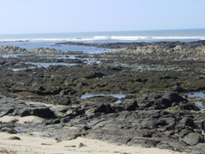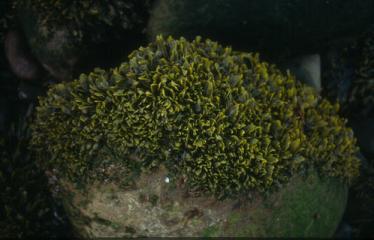
Bladderwrack's humble abode (Habitat)
 Fucus vesiculosus can grow
in the littoral zone, where the tide changes the depth of the water,
and the sublittoral zone, where the organism is constantly
submerged. Being in the littoral zone can cause a couple of
complications for the thallus of bladderwrack. For example, when the low tide comes and the water
recedes further back into the ocean, many organisms are left to
"sunbathe" on rocks, possibly drying out.
Fucus vesiculosus can grow
in the littoral zone, where the tide changes the depth of the water,
and the sublittoral zone, where the organism is constantly
submerged. Being in the littoral zone can cause a couple of
complications for the thallus of bladderwrack. For example, when the low tide comes and the water
recedes further back into the ocean, many organisms are left to
"sunbathe" on rocks, possibly drying out.
Bladderwrack's "hood"
The common distribution for bladderwrack is around the north
Atlantic, in more temperate waters with lower salinity. The picture
at the top of the page, off the shore of Ireland (image courtesy of
Courtney Miller), is an example of the habitat that you can find
bladderwrack in. Shores such as these may lead to the organism not
developing the air bladders that are the signature of bladderwrack
simply because they can be damaged to easily.
A little more sheltered shoreline, where the tide doesn't vary as
much, such as the one upwards and to the right, is where you can find F. vesiculosus with bladders.
The map below shows the distribution across the entire north Atlantic.
 Just
keep swimming... Or not.
Just
keep swimming... Or not.
Bladderwrack is most commonly attached to hard substrata such as
pebbles, rocks, and dense sea beds. The connection to the substrate
is with a discoid holdfast, a root-like structure that simply aids
in anchoring the organism and ensuring it does not get pulled out
into the ocean. The picture to the right shows very young
bladderwracks who have just attached to their new "home." The young
organisms have populated the rock very densely, but some will
probably end up dying due to competition for sunlight.
